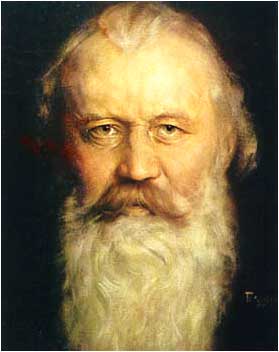Diaz Trio soars in Brahms and Dvorak with pianist Rodriguez

Johannes Brahms
Professional string trios are not in abundant supply since the repertory for this combination of instruments is relatively sparse. Still, when combined with other guest artists the possibilities are expanded, and this is exactly what Wednesday’s concert at the University of Miami’s Gusman Concert Hall offered. Presented by Miami Friends of Chamber Music, the Diaz Trio, with guest pianist Santiago Rodriguez, provided some outstanding musicianship, although there was precious little for the featured combination of violin, viola, and cello.
Although Schubert’s String Trio D 581 was printed in the program, what was actually heard was the earlier Trio in one movement, D. 471. The 19-year-old composer began work on a second movement, an Andante Sostenuto, but abandoned it after thirty-nine measures. The audience, expecting three more movements, was confused and the charm-laden performance of this genial music drew only tepid applause as a result.
Dvorak’s Piano Trio in E minor Op. 90 is his most popular work in the trio genre. Called the “Dumky, or lament, the trio juxtaposes slow and fast tempos in its six sections. Many performances have chosen to link the varied movements together, with the result of listeners not quite knowing when one movement ends and another begins. This was not the case in this performance where a brief pauses were inserted to delineate the composer’s basic four movement plan.
Keeping within the spirit of the music, the folksiness was delivered with gutsy abandon. Pianist Rodriguez ripped into the piece with controlled abandon, as if his life depended on expressing every moment of joy and sadness. Cellist Andres Diaz has a big sound and unleashed it at full fury, seizing every opportunity to soar in this amazing piece of musical folk art. Violinist Andres Cardenes has a tone of great purity and expressive beauty, and his reaches into the soulful laments were breathtakingly lovely.
Closing with Brahms’s Piano Quartet No. 3 in C minor Op. 60 returned violist Roberto Diaz to the group, and brought us in touch with a desolate composer who contemplating putting an end to his life. Fortunately Brahms got over his doldrums, but not before penning the somber and violent first two movements of this remarkable work. The Andante, begins with a sixteen-measure theme, as beautiful as anything Brahms ever wrote. Andres Diaz once again had ample opportunity to dig into this songful cello solo, and reconfirmed that Brahms had a special place in his heart for this instrument. It was a stunning performance, and one that deserved the enthusiastic ovations.
Posted in Performances
Leave a Comment
Thu Dec 9, 2010
at 10:37 am
No Comments




